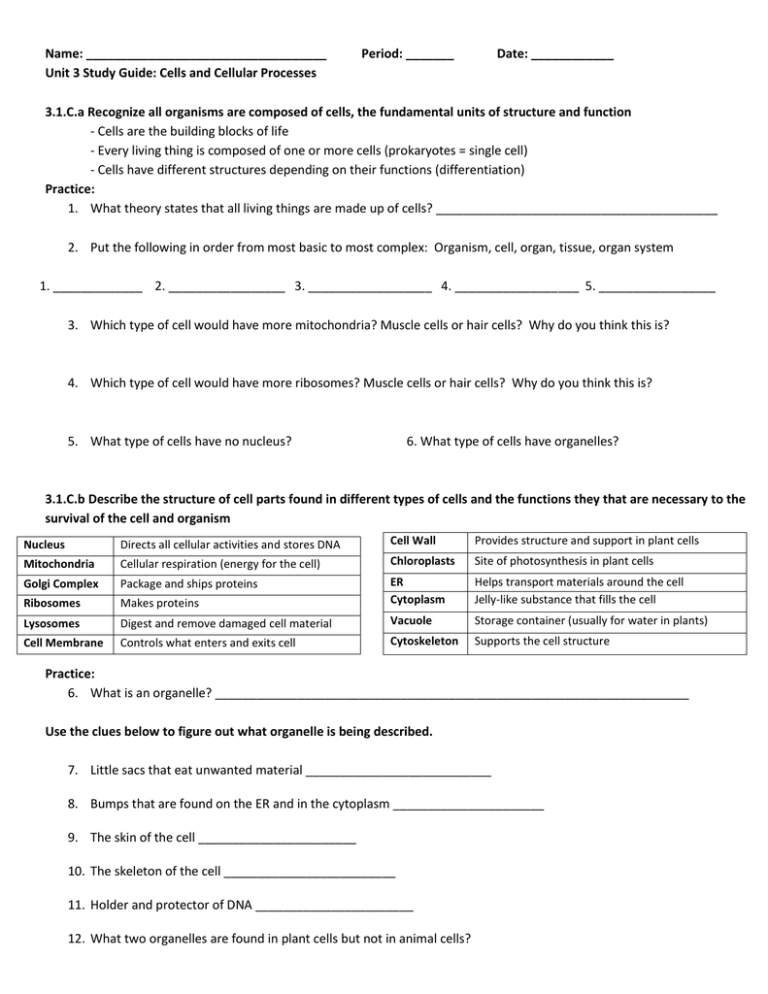Unit 3 study guide
advertisement

Name: ___________________________________ Unit 3 Study Guide: Cells and Cellular Processes Period: _______ Date: ____________ 3.1.C.a Recognize all organisms are composed of cells, the fundamental units of structure and function - Cells are the building blocks of life - Every living thing is composed of one or more cells (prokaryotes = single cell) - Cells have different structures depending on their functions (differentiation) Practice: 1. What theory states that all living things are made up of cells? _________________________________________ 2. Put the following in order from most basic to most complex: Organism, cell, organ, tissue, organ system 1. _____________ 2. _________________ 3. __________________ 4. __________________ 5. _________________ 3. Which type of cell would have more mitochondria? Muscle cells or hair cells? Why do you think this is? 4. Which type of cell would have more ribosomes? Muscle cells or hair cells? Why do you think this is? 5. What type of cells have no nucleus? 6. What type of cells have organelles? 3.1.C.b Describe the structure of cell parts found in different types of cells and the functions they that are necessary to the survival of the cell and organism Nucleus Directs all cellular activities and stores DNA Cell Wall Provides structure and support in plant cells Mitochondria Cellular respiration (energy for the cell) Chloroplasts Site of photosynthesis in plant cells Golgi Complex Package and ships proteins Ribosomes Makes proteins ER Cytoplasm Helps transport materials around the cell Jelly-like substance that fills the cell Lysosomes Digest and remove damaged cell material Vacuole Storage container (usually for water in plants) Cell Membrane Controls what enters and exits cell Cytoskeleton Supports the cell structure Practice: 6. What is an organelle? _____________________________________________________________________ Use the clues below to figure out what organelle is being described. 7. Little sacs that eat unwanted material ___________________________ 8. Bumps that are found on the ER and in the cytoplasm ______________________ 9. The skin of the cell _______________________ 10. The skeleton of the cell _________________________ 11. Holder and protector of DNA _______________________ 12. What two organelles are found in plant cells but not in animal cells? Draw a sketch of a eukaryotic cell with at least FIVE organelles and label them!! 3.2.A.b Compare and contrast the structure and function of cell wall and cell membranes -Cell membrane found in both plants and animals and consists of a phospholipid bilayer - Cell membrane controls what substances can enter and exit the cell -Cell wall is found only in plants and provides structure and support Practice: 13. What is the structure below? __________________________ 14. What do many of the structures make up? ___________________________ A 3. What part of the structure comes into contact with water? 4. What part of the structure does not like water? B 5. What other structure does a plant have in addition to a cell membrane? 15. Why is the cell membrane important? _________________________________________________________ 16. Why is the cell wall important? _______________________________________________________________ 17. Which type of cell has BOTH a cell membrane and cell wall? ________________________________________ 3.2.F.a Explain the significance of the selectively permeable membrane to the transport of molecules - Cell membrane allows only certain materials in and out (semi-permeable) - Larger molecules need proteins to help them cross the cell membrane - Osmosis: movement of water from high to low concentration (form of passive transport) - Diffusion: movement of molecules from high to low concentration (form of passive transport) - Active Transport: movement that requires energy, usually moving from low to high concentration (up the gradient) or moving very large molecules (endo- and exocytosis) Practice: 18. What is the difference between active and passive transport? _____________________________________________ ___________________________________________________________________________________________________ 19. What does selectively permeable mean? ______________________________________________________________ 20. What are some real-life examples of selectively permeable membranes? ____________________________________ ___________________________________________________________________________________________________ 21. What kind of cells have cell membranes? ______________________________________________________________ 3.2.F.b Predict the movement of molecules across a selectively permeable membrane (i.e., diffusion, osmosis, active transport) needed for a cell to maintain homeostasis given concentration gradients and different sizes of molecules - Goal is for concentration of solute and solvent to be equal on both sides of membrane, using as little energy as possible - DRAW A PICTURE to solve prediction problems label water (not particles!) inside + out, draw arrows showing how water moves (hypo- in, hyper- out, iso- same) Practice: 22. If a cell with 3% concentration of salt is placed in a solution of 8% salt, is the solution hypotonic, hypertonic or isotonic? Why? Draw a picture and SHOW YOUR WORK! 23. If a cell with 9% concentration of particles is placed in pure water, is the solution hypotonic, hypertonic or isotonic? Why? Draw a picture and SHOW YOUR WORK! 24. In both examples above what process was taking place? _________________________ Is this an example of active or passive transport? _______________________ Why? 25. Explain what a concentration gradient is. What is it called when a substance needs to move up the concentration gradient? 7.1.D.a Communicate the procedures and results of investigations and explanations through data tables and graphs (bar, single, and multiple line) - Line graphs show change over time - All graphs must contain a title in the following format: Effect of ______(IV)______ on ______(DV)____ - IV and DV must be labeled AND includes units (hours, inches, %, etc) -Include a key if necessary Practice: Number of Skin Cells Produced Number of Muscle Cells Produced Hour 1 8 Hour 2 15 Hour 3 28 Hour 4 39 Hour 5 52 Hour 6 67 4 5 8 12 15 17 26. Which type of cells reproduced faster? ____________________________________________________________ 27. Why do you think this is? _______________________________________________________________________ 28. Which type of cell probably has more mitochondria? Why? ____________________________________________ _____________________________________________________________________________________________





